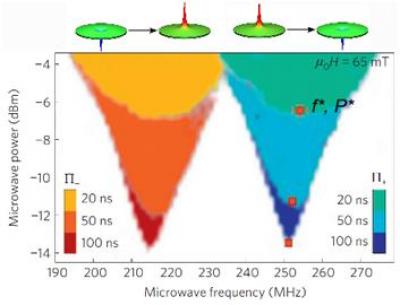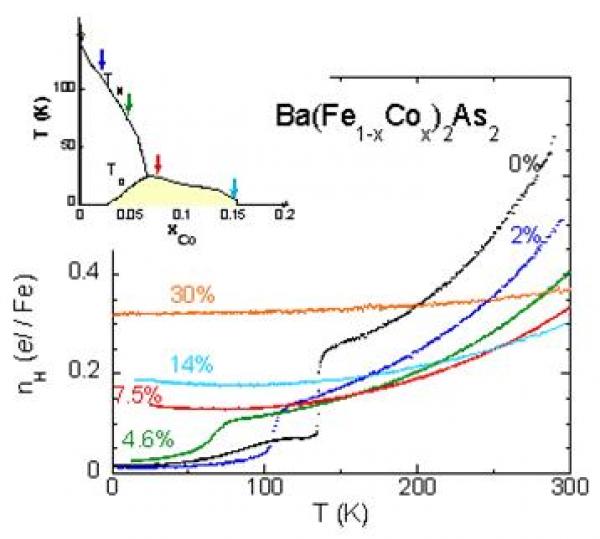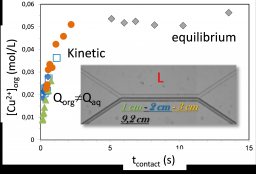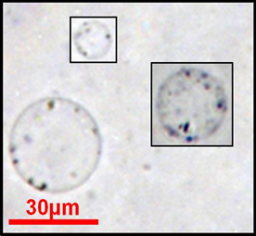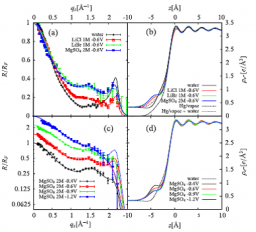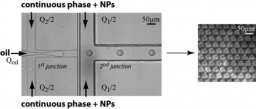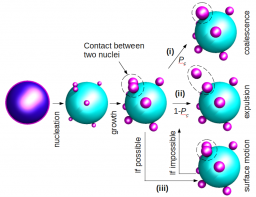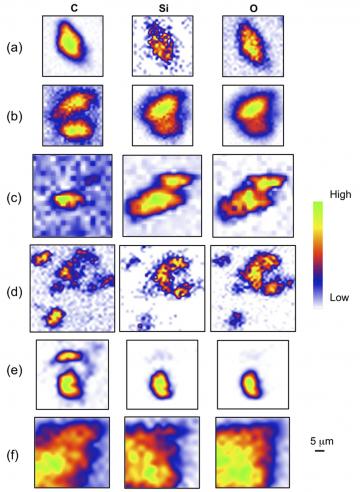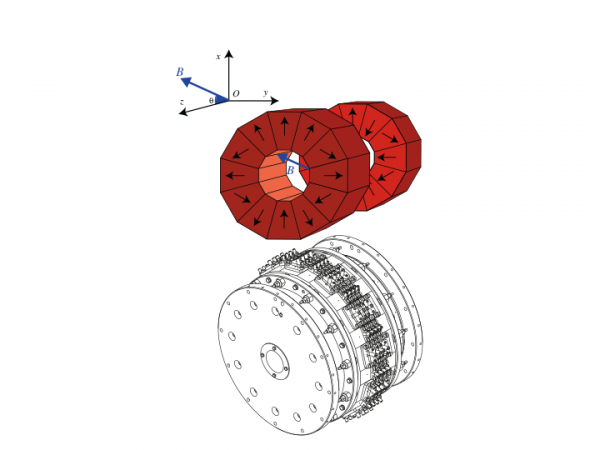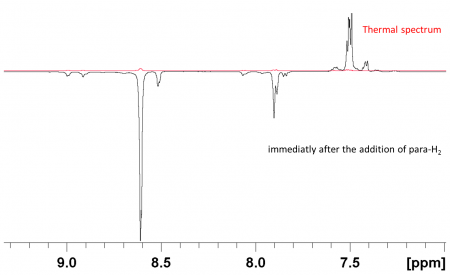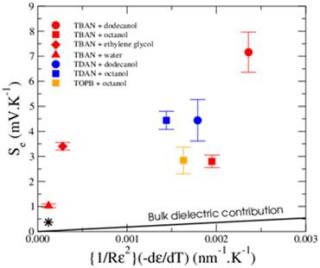Pages scientifiques 2013
The recent discovery that spin angular momentum can be exchanged between the magnetization of an insulating ferromagnet and the conduction electrons of a normal metal layer has opened new perspectives [1]. In particular, it is now possible to incorporate materials such as YIG (Yttrium Iron Garnet, well known for its unsurpassed microwave properties) in innovative spintronic devices. Thanks to the recent progress in the growth of high quality, ultra-thin YIG films [2], electronic control of their relaxation obtained through pure spin currents generated by the spin Hall effect at the interface between a strong spin-orbit metal (e.g., Pt) and YIG might be possible.
Conversely, the spin current emitted by the magnetization precession can be used to probe the YIG dynamics [3,4]. This work is part of a new fruitful axis of research, "magnonics": the use spin waves (magnons) instead of electrons to transmit and process information. The idea is to nanopattern ultra-thin YIG films to take advantage of the specific properties of spin wave propagation in confined geometries and to propose new electronically controlled microwave devices. Magnetic Resonance Force Microscopy [5] is used to perform ferromagnetic resonance on magnetic nanostructures.
[1] Y. Kajiwara, et al., Transmission of electrical signals by spin-wave interconversion in a magnetic insulator. Nature 464, 262 (2010).
[2] O. d'Allivy Kelly, Hahn, et al., Inverse spin Hall effect in nanometer-thick Yttrium Iron Garnet/Pt system. Appl. Phys. Lett. 103,
082408 (2013).
[3] C. Hahn, et al., Comparative measurements of inverse spin Hall effects and magnetoresistance in YIG/Pt and YIG/Ta. Phys. Rev. B 87,
174417 (2013).
[4] C. Hahn, et al., Conduction of spin currents through insulating oxides. arXiv:1310.6000 (2013).
[5] B. Pigeau, C. Hahn, et. al., Measurement of the Dynamical Dipolar Coupling in a Pair of Magnetic Nanodisks Using a Ferromagnetic Resonance Force Microscope. Phys. Rev. Lett. 109, 247602 (2012)
Les nano-oscillateurs à transfert de spin (dénommés ci-après STNO) sont des dispositifs de l'électronique de spin capables d'émettre une onde hyperfréquence monochromatique lorsqu'ils sont pompés par un courant polarisé en spin grâce au couple de transfert de spin (STT) [1,2] . Bien qu'ils offrentde nombreux avantages (agilité spectrale, intégrables sur un circuit onolithique, etc...), leur puissance d'émission est en général très faible.
Une solution est de développer un réseau de STNO couplés, tous synchronisés entre eux. Dans ce cas, la puissance d'émission varierait en N² où N serait le nombre d'oscillateurs. Le but de cette étude expérimentale est d'étudier les différents types de couplages pouvant induire une cohérence de phase entre oscillateurs. On utilisera pour cela une méthode originale de détection de la résonance magnétique directement inspirée des techniques de microscopie en champ proche, la MRFM [3,4]. Le principe de détection consiste à utiliser un micro-levier mécanique avec une sphère magnétique accrochée à son extrémité pour faire de la spectroscopie locale par résonance magnétique. Le SPEC est l'un des deux laboratoires dans le monde qui maîtrise cette approche. Outre sa sensibilité (environ 100 spins) l'outil est aussi capable d'imager la dynamique dans des dispositifs avec une résolution spatiale nano-métrique.
Ce projet de recherche s'inscrit dans le cadre des projets européens Mosaic et ANR P2N Spinnova.
[1] D. C. Ralph & M. D. Stiles, Spin transfer torques, J. Magn. Magn. Mater. 320, 1190 (2008).
[2] A. Slavin & V. Tiberkevich, Nonlinear Auto-Oscillator Theory of Microwave Generation by Spin-Polarized Current. IEEE Trans. Magn. 45, 1875 -1918 (2009).
[3] O. Klein, et al., Ferromagnetic resonance force spectroscopy of individual submicron-size samples. Phys. Rev. B 78, 144410 (2008).
[4] A. Hamadeh, et al., Autonomous and forced dynamics in a spin-transfer nano-oscillator: Quantitative magnetic resonance force microscopy. Phys. Rev. B 85, 140408(R) (2012).
Magnetoresistance, giant or tunnel, is at the heart of several spintronic components, a new branch of electronics based on the spin of the electron with applications in information technology. Because of the never ending drive for miniaturization, spintronics is about to reach the ballistic regime of electronic transport for which spin dependent properties are still not completely understood. Further size reductions can even be achieved in constrictions of atomic sizes obtained by slowly stretching a nanostructure in a sensitively controlled manner. In these systems, static magnetotransport measurements result from the low-dimensional magnetism of a few relevant atoms. In parallel ferro-magnetic resonance (the magnetization precession induced by a radio-frequency magnetic field) has seen a renewed interest lately as it has been shown that magnetization dynamics interacts with spin currents. Its correlation with DC transport is being widely studied and it is now possible to electrically measure ferromagnetic resonance using the inverse spin Hall effect or the Anisotropic Magneto-Resistance (AMR).
The latter can be scaled down to atomic sizes thus giving the possibility to open the unknown field of the dynamical magnetic properties of a single atom in a low dimensional local geometry. We have very recently demonstrated that FMR can be detected in narrow constrictions using the AMR mixed with the RF current auto induced in the magnetic circuit, leading to a measurable DC voltage. After a strong experimental effort, an original setup has been built which allows us to electrically detect the ferromagnetic resonance at 77K in samples that can be broken in real time during the measurements. This unique tool will allow us to study the resonance properties of a single atom in a low-dimensional configuration. It may even allow us to demonstrate that some metals like platinum could become magnetic in these atomic contacts.
Post-doc financé par une bourse européenne "Marie Curie Intra-European Fellowship".
L’objectif principal de cette thèse consiste à développer une sonde à base de capteurs magnétorésistifs (Giant Magnetoresistance – GMR ou Tunnel Magnetoresistance - TMR) afin de mesurer le champ magnétique induit par les courants circulant le long des neurones. L’électrophysiologie classique permet actuellement d’enregistrer les potentiels électriques locaux des cellules nerveuses mais les électrodes utilisées n’apportent pas d’informations sur la signature magnétique de ces cellules. La sonde (appelée "magnétrode" en référence aux électrodes d’électrophysiologie) doit permettre d’obtenir la réponse électromagnétique des neurones, en utilisant la très bonne sensibilité et la possibilité de miniaturisation des capteurs magnétiques très sensibles (GMR ou TMR).
Dans un premier temps, la fabrication, la miniaturisation et la caractérisation des magnétrodes seront effectuées puis des tests in-vitro et in-vivo seront réalisés en collaboration avec respectivement l’équipe d’Alain Destexhe et Thierry Bal de l’Unité de Neurosciences, Information et Complexité (UNIC) du CNRS à Gif-sur-Yvette et celle du Professeur Pascal Fries de l’Ernst Strüngmann Institute (ESI) for Neuroscience in Cooperation with Max Planck Society à Francfort.
Magnetization dynamics in individual vortex-state nanodots has been investigated using the spectroscopic technique of magnetic resonance force microscopy (MRFM) developed in the LNO. It has led to the discovery of future potential magnetic memories based on the resonant switching of the vortex core
A magnetic vortex corresponds to a curling in-plane magnetization distribution leaving a small core region (a few nanometers wide, the size of the exchange length) at the center of the dot, where the magnetization is pointing out-of-plane, either up (polarity p=+1) or down (p=-1). Its lowest energy mode corresponds to a gyrotropic motion of the vortex core about its equilibrium position. This mode has recently attracted practical interest for future magnetic memories and microwave devices by allowing the engineering of the spin-wave excitation spectrum of isolated nanodots and large array of dipolarly coupled nanodots (magnonic crystals).
We have first demonstrated that the frequency degeneracy corresponding to the gyrotropic modes with opposite polarities in zero field can be lifted by applying a magnetic field perpendicular to the disk plane [1] This Zeeman-like splitting can be used for a simple reading of the polarity state in an individual nanodisk. In order to discriminate the resonant frequencies f- and f+ associated respectively to the core polarities p=-1 and p=+1, it is necessary to choose the static magnetic field in such a way that the field-induced gyrotropic frequency splitting exceeds the linewidth of the gyrotropic mode. In our experiment, a bias field as small as µ0H=13 mT is sufficient to fulfill this condition.
We have proposed to take advantage of this frequency discrimination in order to reverse deterministically the vortex core polarity, as shown in references [2]. Starting with the vortex core polarity in, say, the p=+1 state, a single microwave field pulse whose carrier frequency is tuned at f+ and with sufficient amplitude will resonantly excite the gyrotropic motion of the core until it reaches a critical threshold for reversal (see Figure 1). Once it has been reversed, the final state p=-1 is out-of-resonance with the writing pulse so that it cannot be switched back to p=+1. Similarly, it is possible to write the state p=+1 starting from the p=-1 state using the appropriate pulse. This writing process has been shown to be very robust, as no mistake could be recorded out of several hundred attempts with our experimental parameters.
The multiband nature of the iron-based superconductors is a key factor to understanding their physical properties. We have performed a complete study of the charge transport in Ba(Fe1-xCox)2As2 single crystals, in connection with a determination of their electronic structures by photoemission experiments.
In the new Fe-based pnictide superconductors discovered in 2008, the appearance of high-Tc superconductivity in close proximity to the antiferromagnetic phase has been taken as the signature of unconventional superconductivity. It seems now well established that magnetism and superconductivity are directly connected to the peculiar features of the electronic structures of these compounds, which are characterized by small hole and electron pockets. The transport properties of the prototypical Ba(Fe1-xCox)2As2 have been studied throughout the electron doped phase diagram as fine tuning of Co content can be achieved in sizeable single crystals.
« Back to the Group page « Back to the Oxides page
Domain walls are intrinsic to ferroic materials. Long considered as understood, it is only recently, thanks to atomic-resolution studies using transmission electron microscopy (TEM) or atomic force microscopies (AFM, c-AFM, PFM etc.) that their real structural and electronic complexity has been revealed. Based on this, a new paradigm of ferroic devices is now envisaged where the domain walls, rather than the domains, are the active element. This field has been coined “Domain boundary engineering” or “Domain wall nanoelectronics”.
Photoferroelectrics are materials with both photoelectric and ferroelectric properties. As correlated-electron materials, they are attracting increasing interest because of their high technological potential. Recent reports show that low conversion efficiencies can be counterbalanced by large, above-band gap photo-voltages in complex multiferroic oxides and the fundamental role of the potential difference across domain walls.
More detailed and quantitative knowledge of its structural, electronic and chemical nature is necessary. Fundamental questions on the crystal structure and the electronic structure in the vicinity of the domain wall, as well as their behavior under illumination remain to be elucidated.
In the framework of an internal CEA program dedicated to the liquid-liquid extraction for nuclear waste treatment (or primary extraction of uranyl), we have fully characterized the structure of the organic phase with its influence on the phase stability[1],[2] and more recently on the extraction efficiency[3]. Extraction is related to solubilization properties[4] where surfactant and hydrotrope can be used in closed connection to enhance the transfer[5]. In such processes, the liquid-liquid interface plays a key role even though its specific influence is not fully understood. Recently, we took benefit of microfluidic tools to control the interface by making the interfacial reactions predominating over bulk ones. Dedicated home-made chips have shown the possibility to follow kinetic but also to control the shearing properties of the interface
[1] Chapter 7 for Ion Exchange and Solvent Extraction F. Testard, P. Bauduin, L. Berthon, Th. Zemb. Ed B. Moyer, CRC Press, chap 7, P381 (2009).
[2] Berthon L, Testard F, Martinet L, Zemb T, Madic C., C. R. Chimie (2010), 13 1326–1334
[3] Dourdain, S; Hofmeister, I; Pecheur, O; Dufreche, JF; Turgis, R; Leydier, A; Jestin, J; Testard, F; Pellet-Rostaing, S; Zemb, T Langmuir (2012), 28 11319-11328.
[4] Kunz, W., Testard, F., Zemb, Th., Langmuir, (2009), 25(1), 112-115.
[5] Bauduin, P., Zemb, Th., Testard, F., J. Phys. Chem. B (2008) 112, 12354-12360.
Carbonated mineralization as carried out by living organisms like seashells is a very intriguing process leading to crystalline materials that diffract like single crystals while adopting very sophisticated shapes. Nacre is a paradigmatic example of biomineralization, made of water-insoluble organic compartments filled with a CaCO3 mineral phase. We successively considered two model systems to mimic the influence of an organic template on mineralization: first, β-sheet peptide monolayers at the air-water interface and then giant unilamellar polymer vesicles.
Concerning the first model system, two different peptidic sequences, named LSFD and LDFD (respectively 12 and 11 amino-acid long), were designed and evaluated with respect to their ability to form β-sheet layers at the air-water interface[1] and to induce a specific CaCO3 crystallization by selecting the nucleated polymorph and/or its crystallographic orientation.[2] Although the two sequences exhibit a β-sheet conformation at the air-water interface and form 2D crystalline domains, they show unable to direct the mineralization: the selected crystalline polymorph is switched from calcite to vaterite when the interface is covered by any of the two peptidic films, but probably owing to a kinetic effect. Moreover, vaterite crystals appear as a 3D powder with no preferred orientation with respect to the organic “template”. Surprisingly, the Langmuir film made from the more acidic peptide (LDFD) remains stable upon mineralization whereas the LSFD peptide film gets destabilized, likely through an adsorption of the peptides on the growing crystallites.
Within the ANR project ANR-06-BLAN-0276 "SISCI" (Spécificité Ionique dans les Systèmes Colloïdaux et Interfaciaux), we have explored the specific local ionic distributions in water in the vicinity of interfaces between aqueous electrolytes and external media.
Three different X-ray reflectivity techniques have been developed[1]. (i) The air-water interface has been investigated using grazing incidence x-ray fluorescence for different alkali-halide solutions[2]. The measured integrated amount of desorbed ions follows a Hofmeister series, in agreement with the surface tension behavior, and is interpreted in terms of ion-surface interaction potentials. (ii) The spatial ion distribution has been resolved at the sub-nanometer level using x-ray standing waves at the interface with a multilayer silica substrate. (iii) x-ray reflectivity analysis of polarized liquid mercury surface in contact with aqueous electrolyte has shown how the Hg-surface layering and the local ionic profiles depend on both applied potential and ion nature[3].
Emulsions of two immiscible fluids stabilized with solids particles, called Pickering emulsion, have been studied since the early twentieth century and the pioneering works of Ramsden[1] and Pickering[2] The irreversible adsorption of particles at the interface of the two phases gives original properties of these emulsions. Such emulsions are of primary interest in the food, cosmetics industry and oil recovery. Although it is now clear that the stabilization mechanism comes from the partial wettability of the nanoparticles by the two emulsion phases, the interface structures for such a stability mechanism is not well understood. There is a need of making a Pickering emulsion model system where the nanoparticles are well controlled as well as the emulsion size. The LIONS laboratory has developed a microfluidics platform (Fig.6) which allows preparing monodisperse tunable Pickering emulsion starting from monodisperse silica nanoparticles (NPs) of 7nm radius.
Hybrid organic-inorganic nanoparticles with well-controlled morphology are currently of great research interest. Synthetic routes leading to robust aggregates made of nanoparticles of different chemical natures which are associated in a controlled manner, i.e. number of nanoparticles and geometrical arrangement, are especially investigated. Clusters of spheres could mimic the space-filling models of simple molecules and are called “colloidal molecules”. In the framework of the TOCOMO ANR project, the strategy is based on a seeded-growth emulsion polymerization process leading to biphasic particles, which are composed of spherical silica spheres (50-400 nm) surrounded by a varying number of polystyrene (PS) nodules.
Extraterrestrial materials examined by mean of nuclear microprobe
H. Khodjaa,b, T. Smitha,b, C. Engrandc, G. Herzogd, C. Raepsaeta,b
Nuclear Instruments and Methods in Physics Research B 306 (2013) 245–248
- a CEA/IRAMIS/SIS2M/LEEL, F-91191 Gif-sur-Yvette, France
- b CNRS/UMR 3299/SIS2M/LEEL, F-91191 Gif-sur-Yvette, France
- c CSNSM, Bat 104, F-91405, Orsay Campus, France
- d Department of Chemistry and Chemical Biology, Rutgers University, 610 Taylor Road, Piscataway, NJ 08854-8087, USA
Heterogeneous samples are usually studied using solid-state NMR methods and while the sample is spinning at the magic angle. This is problematic for many cases, where the sample cannot be spun, as in MRI. The alternative methodology of spinning the magnetic field around a static sample has been proposed since the 60's, but not yet successfully applied. Our goal is to develop the methodology and the instrumentation in order to perform magic angle field spinning and answer questions related to the monitoring of metabolism in living matter as well as the structure and function of complex systems like batteries, porous media and fuel cells.
The UV-induced DNA lesions at mutational hotspots are not randomly distributed but depend on the base sequence around them. This effect could be related to the redistribution of the electronic excitation energy among the bases. During the past term, we had evidenced that ultrafast energy transfer takes place in model duplexes with repetitive base sequence; this process is possible because the initially populated states are delocalized on more than one base (excitons). It was predicted that this phenomenon should not occur in natural DNA since it is a highly disordered system. Studying the fluorescence of natural DNA, we showed that this prediction was not correct. In this case, the energy transfer process can be mediated by interconversion between ππ* states and charge transfer states. As a result ππ* excitations exhibit multiscale decay, from the femtosecond to the nanosecond time-scale.
The figure shows how photon absorption populates exciton states which may be trapped by charge transfer states. Charge separation and charge recombination to ππ* states gives rise to delayed fluorescence (bold green). Minor contributions to ππ* fluorescence arise during intraband scattering and/or localization of the excitons (thin green).
Natural DNA publications:
I. Vaya, T. Gustavsson, F.A. Miannay, T. Douki, D. Markovitsi: Fluorescence of Natural DNA: From the Femtosecond to the Nanosecond Time Scales, J. Am. Chem. Soc., 132: 11834. 2010.
I. Vayá, T. Gustavsson, T. Douki, Y. Berlin, D. Markovitsi: Electronic Excitation Energy Transfer between Nucleobases of Natural DNA, J. Am. Chem. Soc., 134: 11366. 2012.
The parahydrogen induced polarization (PHIP) method is based on the non-Boltzmann distribution of nuclear spin states following the hydrogenation of a substrate by parahydrogen. Absorptive and/or emissive NMR signals can be greatly enhanced, up to several orders of magnitude as compared to thermally polarized molecules.
The research in this field is part of the expertise of LSDRM in its effort to increase NMR sensitivity.
Dihydrogen, initially made of 1/4 of parahydrogen and 3/4 of orthohydrogen, a proportion that does not induce any hyperpolarization, is cooled to -196°C in the presence of a ferric catalyst, thanks to an home-made apparatus. The resulting gas contains about one half of parahydrogen, and may be use to obtain hyperpolarized spectra.
A first example: the method named "signal amplification by reversible-exchange" (SABRE) is used here to increase the aromatic signals of N,N-dimethylnicotinamide. In SABRE, a catalyst reversibly binds dihydrogen and the aromatic molecule.
Responsable : Marc Briant/Marc-André Gaveau
Cette équipe étudie les mécanismes par lesquels la solvatation affecte la dynamique d’une réaction chimique. Le travail a porté jusqu'à présent sur des réactions d'espèces excitées électroniquement. Une évolution est en cours vers les réactions qui se déroulent à l’état électronique fondamental mais où l'excitation vibrationnelle joue un rôle déterminant.
Responsables : Christian Angelié / Jean-Maïk Soudan
Cette équipe a pour ambition d'apporter une assise numérique réaliste à des concepts aussi importants que changement de phase, ségrégation chimique et d’auto-organisation dans les systèmes Fer/carbone. Des algorithmes et des "codes maisons" sont développés pour traiter de ces questions sur des agrégats comportant plusieurs centaines, voire plusieurs millier d'atomes. Il y a deux aspects à ce travail :
- Développement algorithmique de type Monte Carlo pour aborder des questions de thermodynamique
- Développements méthodologiques sur des potentiels empiriques de type réactif, avec inclusion de propriété magnétiques, pour traiter de l'interaction du fer avec un environnement
Cet axe de recherche a deux motivations:
- Développer de nouveau concepts à même de faire progresser les techniques de simulation numérique des gros systèmes;
- Apporter des outils permettant de modéliser la croissance de nanotubes de carbone sur un catalyseur de fer.
Cet axe a été porté en partie par les programmes nationaux CHIMTRONIC et NANOSIMUL du CEA.
Bibliographie
- J. M. Soudan, M. Basire, J. M. Mestdagh et C. Angelie, A new Monte Carlo method for getting the density of states of atomic cluster systems, Journal of Chemical Physics 135, 144109 (2011) & Erratum Journal of Chemical Physics 135, 229901 (2011)
- M. Basire, J. M. Soudan et C. Angelie, Nanothermodynamics of large iron clusters by means of a flat histogram Monte Carlo method, Journal of Chemical Physics 141, 104304 (2014)
We use time-resolved fluorescence spectroscopy from the femtosecond to the nanosecond time scales to study the dynamics of the interaction between various types of drugs (anti-inflammatory, antitumor, antidiabetic..) and biomolecules (DNA, G-quadruplexes, aninoacids, glycogen…).
These studies are performed in the frame of SLIC/LaserLab Europe in collaboration with colleagues from Germany, Spain, Italy and Greece.
Responsable : Marc Briant/Marc-André Gaveau
Cette équipe étudie les mécanismes par lesquels la solvatation affecte la dynamique d’une réaction chimique. Le travail a porté jusqu'à présent sur des réactions d'espèces excitées électroniquement. Une évolution est en cours vers les réactions qui se déroulent à l’état électronique fondamental mais où l'excitation vibrationnelle joue un rôle déterminant.
Responsable : Lionel Poisson
Cette équipe étudie la dynamique ultrarapide de systèmes hors-équilibre (échelle de temps 10 fs-100 ps). Initialement tourné vers l’étude de molécules isolées (phase gazeuse), cet axe se dirige de plus en plus vers l’étude de systèmes servant de modèle à la chimie en phase condensée : radicaux, systèmes micro-solvatés, nanoparticules,…
Le but de cette équipe est de caractériser l’ensemble de la dynamique d’un système donné, en étudiant sa spectroscopie électronique et la dynamique de relaxation des bandes spectroscopique identifiées. Il s’agit de réaliser la « cartographie dynamique » d’un système d’étude. Pour comprendre ses résultats, il est nécessaire de faire appel à la simulation numérique pour modéliser, a minima, l’environnement proche des systèmes étudiés avant excitation. La sonde des systèmes étant réalisés par ionisation (spectroscopie de photoélectron), la connaissance de la spectroscopie électronique et vibrationnelle de l’ion est aussi nécessaire.
Responsables : Christian Angelié / Jean-Maïk Soudan
Cette équipe a pour ambition d'apporter une assise numérique réaliste à des concepts aussi importants que changement de phase, ségrégation chimique et d’auto-organisation dans les systèmes Fer/carbone. Des algorithmes et des "codes maisons" sont développés pour traiter de ces questions sur des agrégats comportant plusieurs centaines, voire plusieurs millier d'atomes. Il y a deux aspects à ce travail :
- Développement algorithmique de type Monte Carlo pour aborder des questions de thermodynamique
- Développements méthodologiques sur des potentiels empiriques de type réactif, avec inclusion de propriété magnétiques, pour traiter de l'interaction du fer avec un environnement
Cet axe de recherche a deux motivations:
- Développer de nouveau concepts à même de faire progresser les techniques de simulation numérique des gros systèmes;
- Apporter des outils permettant de modéliser la croissance de nanotubes de carbone sur un catalyseur de fer.
Cet axe a été porté en partie par les programmes nationaux CHIMTRONIC et NANOSIMUL du CEA.
Bibliographie
- J. M. Soudan, M. Basire, J. M. Mestdagh et C. Angelie, A new Monte Carlo method for getting the density of states of atomic cluster systems, Journal of Chemical Physics 135, 144109 (2011) & Erratum Journal of Chemical Physics 135, 229901 (2011)
- M. Basire, J. M. Soudan et C. Angelie, Nanothermodynamics of large iron clusters by means of a flat histogram Monte Carlo method, Journal of Chemical Physics 141, 104304 (2014)
The shortage in fossil fuel resources has encouraged a huge effort towards the research of alternative sustainable energy. Within this framework, thermoelectricity offers the possibility to convert low-grade waste heat (including solar heating) into electric power. When a temperature gradient ΔT is applied to an isolated conducting rod, the electrons at the hot part acquire some kinetic energy and diffuse to the cold part, resulting in the creation of an electric field E=-ΔV=SΔT. The proportionality coefficient S is called “Seebeck coefficient”, from the name of the German physicist who discovered this effect. A tremendous effort is currently accomplished in the field of solid-state thermoelectric devices (more than 9,000 publications during the last decade). However, the research of new solid-state thermoelectric materials has reached its limits and most efforts are now devoted to the increase of the conversion efficiency through nanostructuration, which incurs a substantial manufacturing cost.
Nanostructuration is one of the most promising strategies in the quest for next-generation thermoelectric devices. This led us to study the thermoelectric conversion and its fluctuations using a scattering approach suitable for coherent quantum transport. Studying the thermopower of a chaotic quantum dot, we have found that a new family of universal distributions occurs when this is not the bulk but the edges of the dot spectrum which are probed at the Fermi energy. We have also studied disordered nanowires and calculated their thermopowers as well as their figures of merit and their maximal output powers to determine the optimal working conditions for the low temperature thermoelectric conversion.
L'expérience dite de « von Karman » est une expérience consistant à produire un écoulement fluide dans un cylindre à l'aide de turbines munies (ou non) de pales. Ce sujet de recherche a connu un intérêt important dès les années 1990: l'ajout de pales aux turbines a permis d'atteindre des nombres de Reynolds et des taux de turbulence élevés ce qui a permis de vérifier directement plusieurs hypothèses fondamentales en turbulence (intermittence, hypothèses de Taylor, mesures de dissipation).
Cette expérience est utilisée au sein du laboratoire, qui possède une expérience importante de ce type d'écoulements, afin d'observer les diverses brisures de symétrie qui sont induites à la transition vers la turbulence et après cette transition. Les symétries du montage (axisymétrie, symétrie par inversion) permettent de traiter théoriquement le problème en effectuant une analogie avec les résultats de la turbulence à deux dimensions.
Cet écoulement est aussi étudié expérimentalement: deux techniques de visualisation (Vélocimétrie Laser Doppler et Vélocimétrie par Imagerie de Particules) révèlent des propriétés physiques complémentaires sur la turbulence produite par la rotation des turbines.
Cette expérience a mis à jour un grand nombre de résultats théoriques et expérimentaux: le système présente une Beltramisation (alignement vorticité / vitesse) à haut nombre de Reynolds, un hystérésis qui dépend des propriétés du forçage à haut Reynolds, et une éventuelle multi-stabilité rappelant les systèmes à basse dimension pour des conditions de forçage bien précises.
Epitaxial graphene grown on SiC substrate has been intensively studied over the past ten years, in view of its applications in nanoelectronics. The C-terminated face of the substrate offers a particular interest due to its rotational stacking, which decouples adjacent graphene sheets. A major issue is the microscopic surface heterogeneity giving, for example, domains with varying numbers of graphene layers with different electronic and chemical properties. Energy-filtered photoelectron emission microscopy (PEEM) can correlate real space chemical and work function mapping with reciprocal space imaging of the complete band structure of micron scale regions. Therefore, this technique allows a better understanding of the local properties – morphology, chemistry of the interface and electronic properties – which is still required for the development of new electronic devices.
Bright field real and reciprocal space imaging
The photoemission threshold is directly related to the work function (WF) of a material. By fitting the spectrum of each pixel of an image series, acquired over the photoemission threshold, it is therefore possible to map the work function value over the field of view (FoV) of the microscope. This procedure has been applied on an image series of epitaxial graphene on SiC(000-1) (figure 1a). The work function variation is thought to be due to the graphene thickness and the chemistry of the graphene/SiC interface. Similarly, the intensity map of the SiC component of C 1s core level can be used to estimate the thickness variation of the graphene, and can be correlated to the WF map. When the number of graphene layer increases, the SiC peak intensity decreases, relative to the graphene one. In this way, the local thickness of the graphene film can be estimated from the relative SiC and graphene C 1s intensity; within the FoV graphene domains between 1 and 3 monolayers thick are identified.
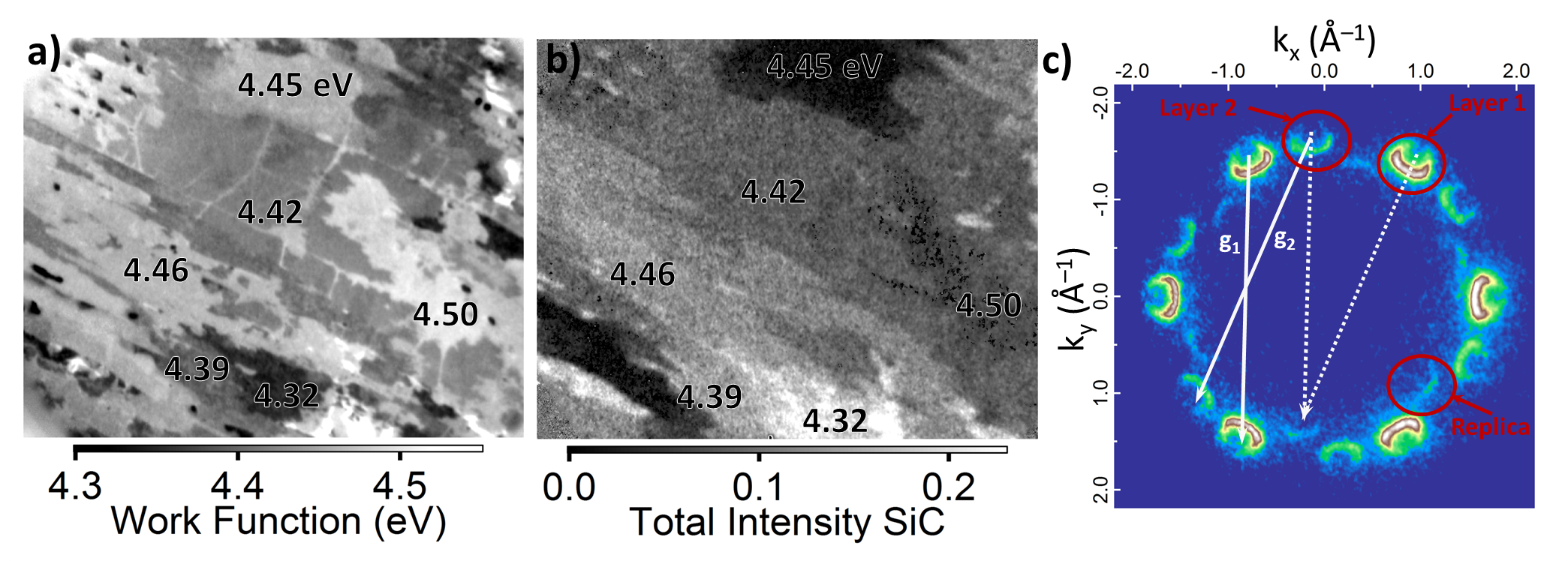
Figure 1: a) Work function map of a 53 μm FoV, using a photon energy of 654.3 eV. b) Intensity map (arbitrary units) of the SiC substrate component of C 1s spectrum after background subtraction for a FoV of 34 μm. c) Constant energy cut in the k-space below the Dirac point, acquired at a binding energy of 1.3 eV, for a graphene bilayer area.
Thanks to the easy switching between the real space and the reciprocal space imaging modes of the NanoESCA (Omicron Nanotechnology), it is possible to obtain the complete band structure of a given area down to 10 µm2, by inserting a field aperture (FA) to select the desired region. A constant energy cut of a graphene bilayer in the k-space below the Dirac point is presented in figure 1c. It shows the presence of two sets of Dirac cones, with the well-known sixfold symmetry. They are attributed to two commensurately rotated graphene sheets, with a rotation angle of 21.9°. A fainter feature presenting also a sixfold symmetry, which appears inside the radius of the most intense ones, is due to a diffraction resulting from the supercell (g1 and g2) formed by the commensurate rotations, as shown in the figure 1c. The reciprocal space imaging mode of the NanoESCA allows immediate visualization of these diffracted cones because it probes all wave vectors parallel to the sample surface.
Dark field imaging
Dark field imaging has been performed using focused He lamp (He I =21.2 eV), on such epitaxial graphene sample grown on a SiC(000-1) substrate. The real space image of the FoV at the photoemission threshold is shown in figure 2a. Figure 2b presents a constant energy cut of the band structure, averaged over the whole FoV. Six commensurate rotation angles are observed (a-f). The contrast aperture in the diffraction plane of the microscope has then been closed to a diameter of 0.11 Å-1 at each of the Dirac cones and the microscope has been switched back to the real space mode. The corresponding real space image shows the spatial origin of photoelectrons for a specific emission angle. By repeating this experiment for each rotational angle, a spatial distribution of the commensurate rotations has been determined (figure 2c). The Dirac cones at the K and K’ point of the first Brillouin zone, typical of graphene, can therefore be used to determine a real spatially-resolved map as function of the photoelectron wave vector.

Figure 2: a) Real space image of the FoV at the photoemission threshold. b) Constant energy cut in the k-space below the Dirac point showing the commensurately rotations of the graphene sheets. c) Reconstructed valence band image from the sum of the dark field images, acquired for the six commensurate rotation angles.
The PEEM study of epitaxial graphene on SiC(000-1) allows the correlation of spatial imaging, which links the WF variation to the number of graphene layer along with its interface chemistry, and to the local band structure, highlighting diffraction effects due to commensurate rotations of the graphene sheets. Dark field PEEM completes the information with a spatially resolved map of the commensurately rotated graphene sheets.
For more information, read the following paper:
Microscopic correlation between chemical and electronic states in epitaxial graphene on SiC(000-1), C. Mathieu, N. Barrett, J. Rault, Y. Mi, B. Zhang, W. A. de Heer, C. Berger, E. Conrad and O. Renault, Physical Review B 83, 235436 (2011).
Laboratory-based real and reciprocal space imaging of the electronic structure of few layer graphene on SiC(000-1) using photoelectron emission microscopy, N. Barrett, K.Winkler, B.Kromker, E.H.Conrad, Ultramicroscopy 130, 94 (2013).
Microscopic chemical and electronic structure of few layer graphene on SiC(000-1), C. Mathieu and N. Barrett, PICO, The Omicron Nanoscience Newsletter 17, 6-8 (2013)












